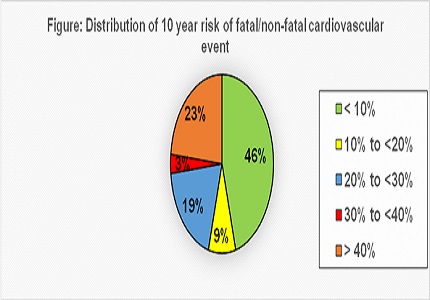Cardiovascular Disease (CVD) Risk estimation among 40 years and older using WHO/ISH risk prediction charts
Abstract
Introduction: Evidence based programme to reduce fatal/non-fatal CVDs can be formulated using WHO/ISH risk prediction charts. Use of combined risk approach is effective in identification of individuals requiring intervention.
Objective: To determine 10 year cardiovascular risk and prevalence of selected risk factors for CVDs among 40 years and older population in an urban field practice area of a medical college.
Material and methods: This was a cross sectional study conducted with sample size of 116. Inclusion criteria was age >40 years and without CVDs. WHO/ISH risk charts were used. Pilot tested, structured, interview based questionnaire was administered followed by clinical examination to determine prevalence of selected CVD risk factors in the community.
Results: Mean age was 56.23 + 10.6 years and majority (74.1%) were females. High 10 year risk of cardiovascular events, family history of CVDs, high BMI, increased risk of metabolic complications, abdominalobesity, hypertension and smoking was seen in 23%,33.6%,79.3%,44.8%,52.6%,56.9% and 10.3% respectively. Significant gender difference was seen in prevalence of smoking, physical inactivity, over weight, increased risk of metabolic complications, and abdominal obesity (p= 0.044, 0.036, 0.000, 0.000, and 0.001 respectively). Higher prevalence of Hypertension, Diabetes, abdominal obesity, overweight, and smoking was found in individuals at high 10 year risk of CVD event.
Conclusion: The present study document high 10-year risk of cardiovascular events and prevalence of risk factors. Identification of individuals at high risk of CVDs is crucial to mitigate rapidly growing CVD burden in the country.
Downloads
References
2. Mendis S, Lindholm LH, Anderson SG, Alwan A, Koju R, Onwubere BJ, et al. Total cardiovascular risk approach to improve efficiency of cardiovascular prevention in resource constrain settings. J Clin Epidemiol. 2011;64(12):1451-62. [PubMed]
3. Ferket BS, Colkesen EB, Visser JJ, Spronk S, Kraaijenhagen RA, Steyerberg EW, Hunink MG. Systematic review of guidelines on cardiovascular risk assessment: Which recommendations should clinicians follow for a cardiovascular health check? Arch Intern Med. 2010 Jan 11;170(1):27-40. doi: 10.1001/archinternmed.2009.434. [PubMed]
4. WHO. Cardiovascular diseases[Internet]. World Health Organization [Cited 23 May 2016]. Available from: http://www.who.int/cardiovascular_diseases/en/
5. WHO. Prevention of Cardiovascular Disease: Guidelines for Assessment and Management of Cardiovascular risk. Geneva: World Health Organization. WHO Press; 2007.
6. Cooney MT, Dudina A, D'Agostino R, Graham IM. Cardiovascular risk-estimation systems in primary prevention do they differ? Do they make a difference? Can we see the future? Circulation. 2010;122(3):300-10. [PubMed]
7. Gaziano TA, Young CR, Fitzmaurice G, Atwood S, Gaziano JM.Laboratory-basedversusnon-laboratory-basedmethod for assessment of cardiovascular diseaserisk: theNHANES I Follow-up Studycohort. Lancet. 2008 Mar 15;371(9616):923-31. doi: 10.1016/S0140-6736(08)60418-3. [PubMed]
8. Beswick AD, Brindle P, Fahey T, Ebrahim S. A Systematic Review of Risk Scoring Methods and Clinical Decision Aids Used in the Primary Prevention of Coronary Heart Disease (Supplement) [Internet].
9. Kariuki JK, Stuart-Shor EM, Leveille SG, Hayman LL. Evaluation of the performance of existing non-laboratory based cardiovascular risk assessment algorithms. BMC CardiovascDisord. 2013;13(1):1.
10. Lloyd-Jones DM. Cardiovascular risk prediction basic concepts, current status, and future directions. Circulation. 2010;121(15):1768-77.
11. Shrivastava SR, Ghorpade AG, Shrivastava PS. A Community-based Cross-sectional Study of Cardiovascular Risk in a Rural Community of Puducherry. Heart Views. 2015;16(4):131-6.
12. WHO, UNAIDS. Prevention of cardiovascular disease: World Health Organization; 2007.
13. Goh LG, Dhaliwal SS, Welborn TA, Lee AH, Della PR. Anthropometric measurements of general and central obesity and the prediction of cardiovascular disease risk in women: a cross-sectional study. BMJ open. 2014;4(2):e004138.
14. WHO Expert Consultation. Appropriate body-mass index for Asian populations and its implications for policy and intervention strategies. Lancet. 2004 Jan 10;363(9403):157-63. [PubMed]
15. Aswin K, Ghorpade AG, Kar SS, Kumar G. Cardiovascular disease risk factor profiling of group C employees in Jipmer, Puducherry. Journal of family medicine and primary care. 2014;3(3):255.
16. Kar SS, Thakur JS, Virdi NK, Jain S, Kumar R.Risk factors for cardiovascular diseases: is the socialgradientreversing in northernIndia? Natl Med J India. 2010 Jul-Aug;23(4):206-9. [PubMed]
17. Samuel P, Antonisamy B, Raghupathy P, Richard J, Fall CH.Socio-economic status and cardiovascularrisk factors in rural and urbanareas of Vellore, Tamilnadu, SouthIndia. Int J Epidemiol. 2012 Oct;41(5):1315-27. doi: 10.1093/ije/dys001. Epub 2012 Feb 24. [PubMed]
18. Shrivastava SR, Ghorpade AG, Shrivastava PS. A community-based cross-sectional study of cardiovascular risk in a rural community of Puducherry. Heart Views. 2015;16(4):131. [PubMed]
19. Otgontuya D, Oum S, Buckley BS, Bonita R.Assessment of totalcardiovascularrisk using WHO/ISHriskpredictioncharts in threelow and middleincomecountries in Asia. BMC Public Health. 2013 Jun 5;13:539. doi: 10.1186/1471-2458-13-539. [PubMed]
20. Dhungana R, Khanal M, Pandey A, Thapa P, Devkota S, Mumu S, et al. Assessment of Short Term Cardiovascular Risk Among 40 Years and Above Population in a Selected Community of Kathmandu, Nepal. Journal of Nepal Health Research Council. 2015.
21. Piskorz D, Bongarzoni L, Citta L, Citta N, Citta P, Keller L, et al. World Health Organization cardiovascular risk stratification and target organ damage. Hipertension y riesgo vascular. 2015.
22. Gupta R, Gupta V, Sarna M, Prakash H, Rastogi S, Gupta K. Serial epidemiological surveys in an urban Indian population demonstrate increasing coronary risk factors among the lower socioeconomic strata. Journal-Association of physicians of India. 2003;51:470-8.
23. Misra A, Pandey RM, Devi JR, Sharma R, Vikram NK, Khanna N.Highprevalence of diabetes, obesity and dyslipidaemia in urbanslumpopulation in northernIndia. Int J Obes Relat Metab Disord. 2001 Nov;25(11):1722-9. [PubMed]
24. Ndindjock R, Gedeon J, Mendis S, Paccaud F, Bovet P. Potential impact of single-risk-factor versus total risk management for the prevention of cardiovascular events in Seychelles. Bull World Health Organ. 2011;89(4):286-95.

Copyright (c) 2017 Author (s). Published by Siddharth Health Research and Social Welfare Society

This work is licensed under a Creative Commons Attribution 4.0 International License.


 OAI - Open Archives Initiative
OAI - Open Archives Initiative


